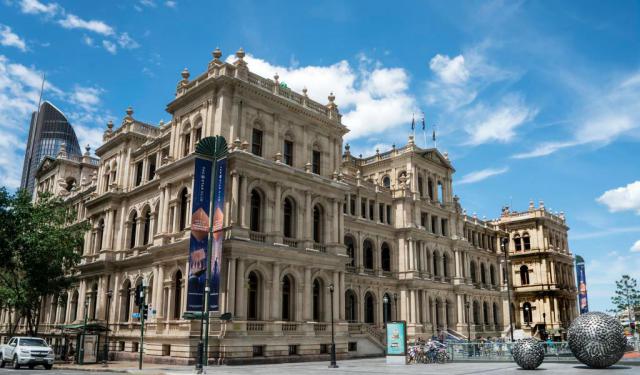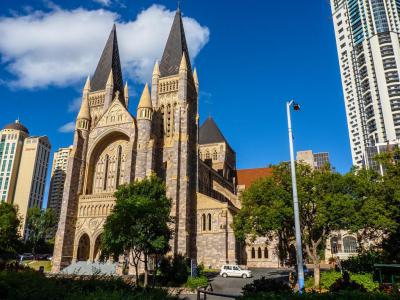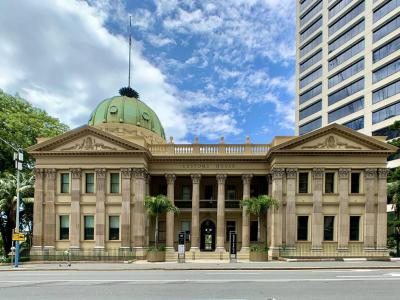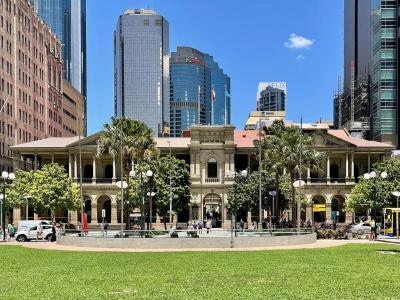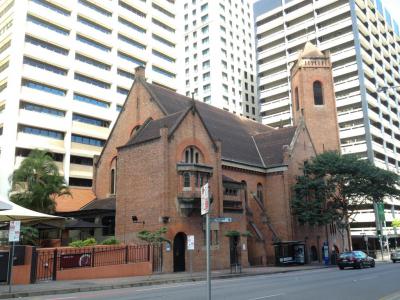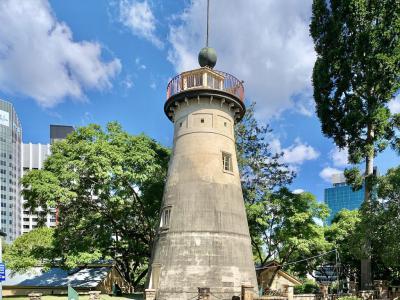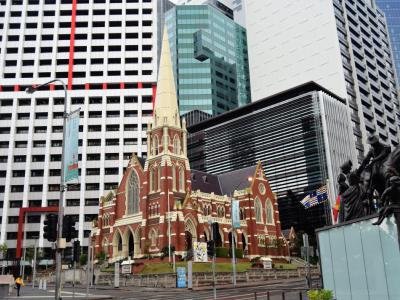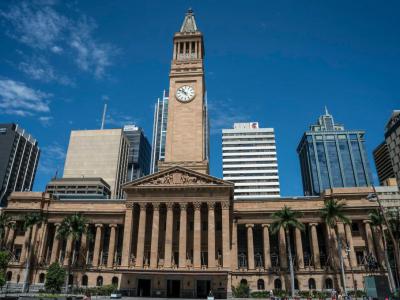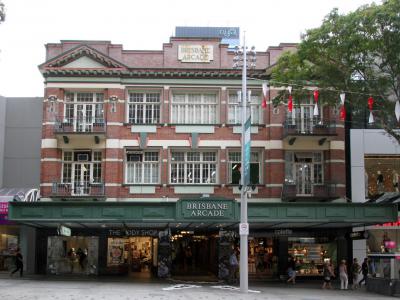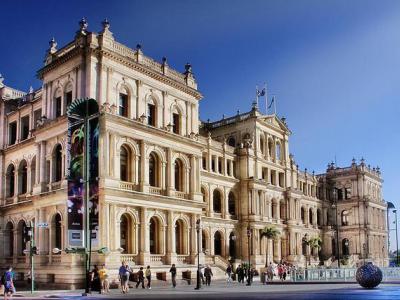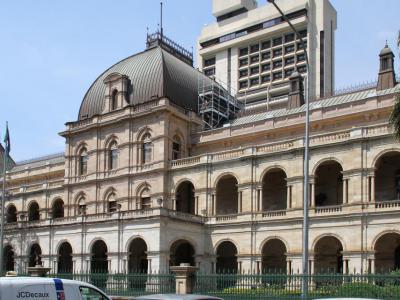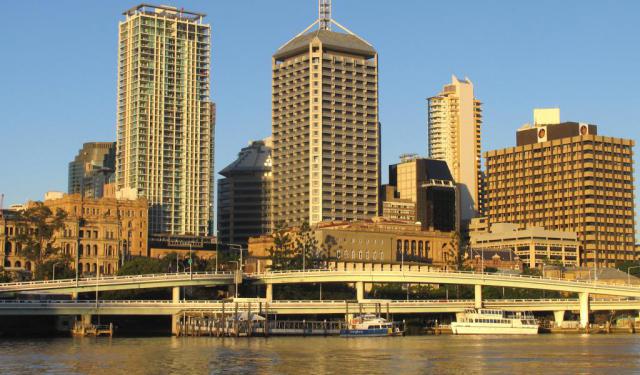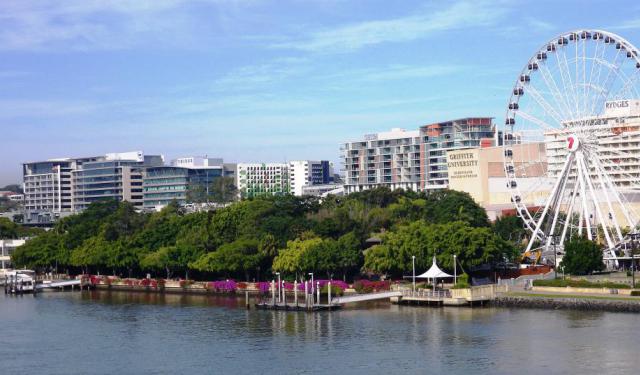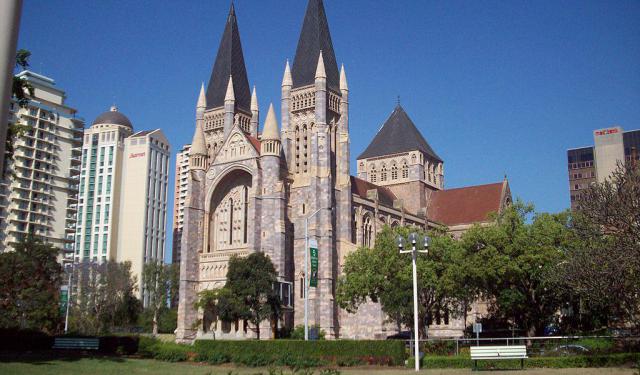Brisbane Heritage Architecture Tour (Self Guided), Brisbane
Brisbane, Australia, abounds in places where you can get a real sense of what it was like in colonial times. Featuring different types of architecture – Colonial, Gothic, or Neo-classic – today these exquisite buildings are used for all sorts of purposes, from cultural events to local administration. Together they make Brisbane a beautiful city while telling the story of its development over the years.
One such cherished landmark is Saint John's Cathedral. With its stunning Gothic Revival design, this magnificent church is an architectural masterpiece and a spiritual center for the community.
Customs House, located along the Brisbane River, is a grand building known for its Victorian-style masonry. Originally serving as a customs office, it is now owned by the University of Queensland and used for public and private functions, although retaining its historic charm.
The General Post Office Building, an elegant sandstone structure, is hard to miss for its clock tower and intricate details, making it a prominent feature in Brisbane's cityscape.
Saint Andrews Church, another beautiful place of worship with a timeless appeal, showcases a blend of architectural trends, including Gothic and Romanesque elements.
The Old Windmill is a unique heritage site that was once used as a windmill and a signal tower. It offers panoramic views of the city and serves as a reminder of Brisbane's early history.
Albert Street Uniting Church, with its neo-Gothic design, is a serene sanctuary known for its stained glass windows and peaceful ambiance.
Meanwhile, the impressive Brisbane City Hall, home to the Museum of Brisbane, is an iconic example of Classicism. Another two governmental sites of distinction include the Treasury Building, an architectural gem of Renaissance Revival, currently serving as a casino, and Brisbane Parliament House, a majestic neoclassical edifice.
On the other hand, Brisbane Arcade is a shopping venue that elegantly showcases Art Deco construction.
Visiting these sites in Brisbane is an opportunity to appreciate the city's architectural and cultural diversity. Anyone who's a history buff or simply looking to explore the beauty of Brisbane will find this experience truly captivating.
One such cherished landmark is Saint John's Cathedral. With its stunning Gothic Revival design, this magnificent church is an architectural masterpiece and a spiritual center for the community.
Customs House, located along the Brisbane River, is a grand building known for its Victorian-style masonry. Originally serving as a customs office, it is now owned by the University of Queensland and used for public and private functions, although retaining its historic charm.
The General Post Office Building, an elegant sandstone structure, is hard to miss for its clock tower and intricate details, making it a prominent feature in Brisbane's cityscape.
Saint Andrews Church, another beautiful place of worship with a timeless appeal, showcases a blend of architectural trends, including Gothic and Romanesque elements.
The Old Windmill is a unique heritage site that was once used as a windmill and a signal tower. It offers panoramic views of the city and serves as a reminder of Brisbane's early history.
Albert Street Uniting Church, with its neo-Gothic design, is a serene sanctuary known for its stained glass windows and peaceful ambiance.
Meanwhile, the impressive Brisbane City Hall, home to the Museum of Brisbane, is an iconic example of Classicism. Another two governmental sites of distinction include the Treasury Building, an architectural gem of Renaissance Revival, currently serving as a casino, and Brisbane Parliament House, a majestic neoclassical edifice.
On the other hand, Brisbane Arcade is a shopping venue that elegantly showcases Art Deco construction.
Visiting these sites in Brisbane is an opportunity to appreciate the city's architectural and cultural diversity. Anyone who's a history buff or simply looking to explore the beauty of Brisbane will find this experience truly captivating.
How it works: Download the app "GPSmyCity: Walks in 1K+ Cities" from Apple App Store or Google Play Store to your mobile phone or tablet. The app turns your mobile device into a personal tour guide and its built-in GPS navigation functions guide you from one tour stop to next. The app works offline, so no data plan is needed when traveling abroad.
Brisbane Heritage Architecture Tour Map
Guide Name: Brisbane Heritage Architecture Tour
Guide Location: Australia » Brisbane (See other walking tours in Brisbane)
Guide Type: Self-guided Walking Tour (Sightseeing)
# of Attractions: 10
Tour Duration: 2 Hour(s)
Travel Distance: 3.5 Km or 2.2 Miles
Author: gene
Sight(s) Featured in This Guide:
Guide Location: Australia » Brisbane (See other walking tours in Brisbane)
Guide Type: Self-guided Walking Tour (Sightseeing)
# of Attractions: 10
Tour Duration: 2 Hour(s)
Travel Distance: 3.5 Km or 2.2 Miles
Author: gene
Sight(s) Featured in This Guide:
- St. John's Cathedral
- Customs House
- General Post Office Building
- St. Andrews Church
- The Old Windmill
- Albert Street Uniting Church
- Brisbane City Hall and Museum of Brisbane
- Brisbane Arcade
- Treasury Building
- Brisbane Parliament House
1) St. John's Cathedral
Saint John’s Cathedral is one of the most impressive churches in Brisbane and is used for important Anglican occasions such as the ordination of priests or deacons. In addition, it is an important part of the Brisbane arts scene with its own orchestra that holds many events and concerts throughout the year. It is also home to the largest cathedral pipe organ in Australia and has an acclaimed choir. In the tradition of grand medieval cathedrals in Europe, Saint John’s is the only Australian cathedral that has been completed over more than a century with stonemasons, architects and the diocese working together.
The work has resulted in a stunning Gothic revival cathedral designed by one of England’s most prestigious 19th century architects, John Loughborough Pearson. This was to be his final masterpiece and he died just prior to the final plans being approved. The project was taken over by his son Frank. The most recent additions to the cathedral have been the western spires clad in copper, which were hoisted into place in 2008. One of the highlights of the interior of the cathedral are the mosaics brought back from the “Holy Land” by WWI Australian light horsemen: you can see them in front of the cathedral altar.
The work has resulted in a stunning Gothic revival cathedral designed by one of England’s most prestigious 19th century architects, John Loughborough Pearson. This was to be his final masterpiece and he died just prior to the final plans being approved. The project was taken over by his son Frank. The most recent additions to the cathedral have been the western spires clad in copper, which were hoisted into place in 2008. One of the highlights of the interior of the cathedral are the mosaics brought back from the “Holy Land” by WWI Australian light horsemen: you can see them in front of the cathedral altar.
2) Customs House
Customs House is one of Brisbane’s most beautiful colonial buildings and its location on the shores of the Brisbane River make it even more impressive. The building once played a key role in the city’s economics – it was built in 1886 to replace a humble custom’s house at Petrie Bight. It was designed by Charles McLay of the Colonial Architect’s Office and is a magnificent example of the Victorian Free Classical style. The exterior of the building is dominated by the impressive copper dome roof and its beautiful portico.
The building is now owned by the University of Queensland and is used for public and private functions – you can often find art exhibitions or music concerts being held inside. Some of the rooms are open to visitors to enjoy and take in the significant history of the building and remind us that Brisbane was once a great port city. Within Customs House, the Long Room is the grandest and there are historical displays inside showing the building as it was in its heyday. There is also a charming restaurant that can be visited by the public and provides the perfect chance to imagine Brisbane as it was in Victorian times.
The building is now owned by the University of Queensland and is used for public and private functions – you can often find art exhibitions or music concerts being held inside. Some of the rooms are open to visitors to enjoy and take in the significant history of the building and remind us that Brisbane was once a great port city. Within Customs House, the Long Room is the grandest and there are historical displays inside showing the building as it was in its heyday. There is also a charming restaurant that can be visited by the public and provides the perfect chance to imagine Brisbane as it was in Victorian times.
3) General Post Office Building
The General Post Office building is a beautiful historical building first opened on 28 September 1872. The building is made of sandstone and features deep verandahs and high ceilings. The site where the building sits today once stood a prison that housed women convicts. The prison building was demolished in 1871 to make room for the new post office building.
A clock mounted in the pediment positioned above the main entrance was once illuminated by a gas powered light. It was later replaced by a smaller, electric clock. The first typewriter to be used in any post office in any Australian city was used at this building in 1892.
The square in front of the General Post Office building is called Post Office Square. There are various statues and fountains within the square. One is a statue of Major-General Thomas William Glasgow who was leader of one of the light horse brigades that landed at Anzac Cove in Gallipoli and later a Senator for Queensland. Post Office Square is well known for its excellent food court where each day the hoards head for a bite to eat.
A clock mounted in the pediment positioned above the main entrance was once illuminated by a gas powered light. It was later replaced by a smaller, electric clock. The first typewriter to be used in any post office in any Australian city was used at this building in 1892.
The square in front of the General Post Office building is called Post Office Square. There are various statues and fountains within the square. One is a statue of Major-General Thomas William Glasgow who was leader of one of the light horse brigades that landed at Anzac Cove in Gallipoli and later a Senator for Queensland. Post Office Square is well known for its excellent food court where each day the hoards head for a bite to eat.
4) St. Andrews Church
Saint Andrews Church is one of Brisbane’s grandest churches, built in Romanesque style; it is well known for its grand pipe organ. The church was built in 1905 as Presbyterian, but became a Uniting Church when the non-conformist denominations merged in 1977. Originally the congregation met on Wickham Terrace, but when their space was needed for railways a competition was held for the design of the proposed church on the corner of Ann and Creek Streets. It was won by George Payne who presented plans for a Neo-Romanesque style and bagged the 100 pounds reward. Although it was originally viewed with some trepidation by Brisbane residents who were expecting a grand Gothic design, it is now heavily regarded as the finest example of Neo-Romanesque in the Southern Hemisphere.
In the 1920s the Saint Andrews underwent extensive renovations with a more ornate entrance from Ann Street into the sanctuary and from Creek Street into the Hall added. In this same period the stunning stained glass windows of the church were finally completed. The church was most recently refurbished in 1999. One of the main features of the façade is the bell tower, which is still used to call the congregation to church on Sundays.
In the 1920s the Saint Andrews underwent extensive renovations with a more ornate entrance from Ann Street into the sanctuary and from Creek Street into the Hall added. In this same period the stunning stained glass windows of the church were finally completed. The church was most recently refurbished in 1999. One of the main features of the façade is the bell tower, which is still used to call the congregation to church on Sundays.
5) The Old Windmill
The Old Windmill is Queensland’s oldest surviving building and one of the very few convict built buildings to remain in the city. It was constructed in 1824 to grind maize and wheat to feed the convict population of the colony. Originally a treadmill the mill, but the cloth sails were added a couple of months after its inauguration; however the treadmill was still put to use as a form of punishment. In 1841 two aboriginal men were hung from the windmill after they were deemed to have been guilty of murdering two members of a surveying party at Mount Lindsay.
Around 1849 the windmill was decommissioned and was put to use as Queensland’s first museum and during the 1930s and 1940s it was used as a broadcasting tower. In fact, it is thought that this was the site of the very first TV broadcast in Australia in 1934. In 1866 a cannon was installed at the windmill and was fired each day at precisely 1pm for the residents of the colony to set their watches by.
Around 1849 the windmill was decommissioned and was put to use as Queensland’s first museum and during the 1930s and 1940s it was used as a broadcasting tower. In fact, it is thought that this was the site of the very first TV broadcast in Australia in 1934. In 1866 a cannon was installed at the windmill and was fired each day at precisely 1pm for the residents of the colony to set their watches by.
6) Albert Street Uniting Church
The Albert Street Uniting Church began construction in 1889 and is an excellent example of the Victorian Gothic Revival style that was so popular in the colony at the time. The first Methodist congregation of Brisbane began in 1849 and met at an Albert Street address, but as the church grew it became clear that a larger space was required. A competition to choose the design was established and G H M Addison won for his plans. On August 18, 1888 five foundation stones were laid down by high profile parishioners and the church was completed in 1889. It features a cruciform shape, with a steeply pitched roof and buttressing and a high bell tower and spire.
In the tradition of the Methodist Church there was a heavy emphasis on music and a grand organ was installed. The organ came from England and was enveloped in gold leaf. The design means that the organ and the pulpit are the direct focus of the seated congregation. The church is open Monday to Friday to visitors from 10am to 2pm and you can arrange for tours of the church in advance – it is free, but a small donation is appreciated.
In the tradition of the Methodist Church there was a heavy emphasis on music and a grand organ was installed. The organ came from England and was enveloped in gold leaf. The design means that the organ and the pulpit are the direct focus of the seated congregation. The church is open Monday to Friday to visitors from 10am to 2pm and you can arrange for tours of the church in advance – it is free, but a small donation is appreciated.
7) Brisbane City Hall and Museum of Brisbane
Brisbane City Hall is located in King George Square. The building is widely considered to be one of the most ornate and beautiful of Australia’s city halls. The foundation stone of the building was laid in 1920 and construction was completed by 1930. For many years the hall was Brisbane’s tallest building and to this day you can take the elevator to the top of the clock tower and get an impressive panoramic view over the city. The viewing platform is open 10am to 3pm every day, and there is no admission fee. The clock tower is 91 meters above the ground and was inspired by Saint Mark’s Campanile in Venice, Italy.
Built in the Italian Renaissance style, there is much to see in the building. Above the Corinthian columns at the entrance to the building is the ornately carved tympanum, which was carved by Sculptor Daphne Mayo in the 1930s. It features scenes of the settlement of Queensland with cattle drovers extending out into the lands filled with kangaroos. Inside there are many beautiful rooms, but the highlight is the main auditorium inspired by the Pantheon in Rome.
On the city hall's third floor, you will find the Museum of Brisbane which is dedicated to showcase the different facets, historical and contemporary, of this sub-tropical state capital city. You will find fascinating displays of all aspects of the city. The ethos of the museum is to guide visitors towards developing an understanding of Brisbane’s people and communities and how they have worked together to create the city that you see today. It also encourages visitors to envisage the city that will become in the future.
Built in the Italian Renaissance style, there is much to see in the building. Above the Corinthian columns at the entrance to the building is the ornately carved tympanum, which was carved by Sculptor Daphne Mayo in the 1930s. It features scenes of the settlement of Queensland with cattle drovers extending out into the lands filled with kangaroos. Inside there are many beautiful rooms, but the highlight is the main auditorium inspired by the Pantheon in Rome.
On the city hall's third floor, you will find the Museum of Brisbane which is dedicated to showcase the different facets, historical and contemporary, of this sub-tropical state capital city. You will find fascinating displays of all aspects of the city. The ethos of the museum is to guide visitors towards developing an understanding of Brisbane’s people and communities and how they have worked together to create the city that you see today. It also encourages visitors to envisage the city that will become in the future.
8) Brisbane Arcade
The Brisbane Arcade is a historical building that contains one of the city’s most charming shopping arcades. In addition to its art deco style architecture, the arcade is of historical importance as it was built by one of Brisbane’s most important and mysterious colonial families – the Maynes.
The arcade was built by siblings James and Mary Mayne and opened in 1924 on the land their brother Isaac had bought in 1892. The Mayne family was also responsible for donating the land used to form the University of Queensland at the beginning of the 20th century. Their family had a murky past of madness and murder as it was said that their father Patrick had begun his immense fortune with money he had stolen from a man he murdered on the banks of the Brisbane River in the mid 19th century.
There is entry to the arcade from both Queen Street and Adelaide Street and inside there are two levels of retail stores. Each level has ornate floral moldings on the pilasters on the first level there are stylish wrought iron railings. Stepping into the arcade is like stepping back into the jazz age of the 1920s and its romantic nouveau aesthetic. Many of Brisbane’s most respected designers have boutiques here.
The arcade was built by siblings James and Mary Mayne and opened in 1924 on the land their brother Isaac had bought in 1892. The Mayne family was also responsible for donating the land used to form the University of Queensland at the beginning of the 20th century. Their family had a murky past of madness and murder as it was said that their father Patrick had begun his immense fortune with money he had stolen from a man he murdered on the banks of the Brisbane River in the mid 19th century.
There is entry to the arcade from both Queen Street and Adelaide Street and inside there are two levels of retail stores. Each level has ornate floral moldings on the pilasters on the first level there are stylish wrought iron railings. Stepping into the arcade is like stepping back into the jazz age of the 1920s and its romantic nouveau aesthetic. Many of Brisbane’s most respected designers have boutiques here.
9) Treasury Building
The Treasury Building in Brisbane, once known as the New Public Offices, is a historic building formerly used for government administration. Constructed between 1886 and 1928, it served the Queensland Government. This Italian Renaissance style edifice was recognized as a heritage site on October 21, 1992, and added to the Queensland Heritage Register.
Situated at North Quay, close to Victoria Bridge's north end, the building spans a whole city block, bordered by Queen Street, George Street, Elizabeth Street, and William Street, though its official address is on Queen Street. Facing Elizabeth Street, it's directly across from Queens Gardens. In the late 1800s and early 1900s, the Treasury Building was a prominent symbol of self-rule and a center for various celebrations and nationalistic events.
Architecturally, the building reflects late 19th-century English styles, drawing inspiration from 16th-century Italian classical design. Its three facades are lined with arcades. These facades are symmetrical, featuring central towers that are slightly taller and topped with pediments. The building's corners are marked by protruding pavilions that end the arcades. The basement is notable for its smooth, horizontally lined rustication.
The exterior is mainly covered with sandstone ashlar, except for the inner arcade walls, which are made of brick and rendered to mimic ashlar. Different construction phases used various types of sandstone, noticeable in the color differences between the Highfields stone from the initial phase and the Helidon stone in later stages. The building's foundation is set on a porphyry base, and some sides have a matching low porphyry wall with a wrought iron fence atop it.
Today, the Treasury Building houses the Treasury Casino, operated by the Star Entertainment Group.
Situated at North Quay, close to Victoria Bridge's north end, the building spans a whole city block, bordered by Queen Street, George Street, Elizabeth Street, and William Street, though its official address is on Queen Street. Facing Elizabeth Street, it's directly across from Queens Gardens. In the late 1800s and early 1900s, the Treasury Building was a prominent symbol of self-rule and a center for various celebrations and nationalistic events.
Architecturally, the building reflects late 19th-century English styles, drawing inspiration from 16th-century Italian classical design. Its three facades are lined with arcades. These facades are symmetrical, featuring central towers that are slightly taller and topped with pediments. The building's corners are marked by protruding pavilions that end the arcades. The basement is notable for its smooth, horizontally lined rustication.
The exterior is mainly covered with sandstone ashlar, except for the inner arcade walls, which are made of brick and rendered to mimic ashlar. Different construction phases used various types of sandstone, noticeable in the color differences between the Highfields stone from the initial phase and the Helidon stone in later stages. The building's foundation is set on a porphyry base, and some sides have a matching low porphyry wall with a wrought iron fence atop it.
Today, the Treasury Building houses the Treasury Casino, operated by the Star Entertainment Group.
10) Brisbane Parliament House
Brisbane Parliament House is the seat of the Queensland State Parliament, which is a unicameral institution and the only parliament of its kind in Australia. Following the separation of Queensland from New South Wales in 1859, a grand building was ordered to be built. Robert Tiffin’s design was selected in 1863 following an Australia wide competition. The French Renaissance style construction was inaugurated in 1868 although additions such as the colonnades were not completed until 1878.
When you enter the main entrance you are greeted by a Minton tile European imported foyer and grand staircase, which leads up to the Chambers and the Reading Room. In the Red Chamber, which was the Upper House until it was abolished in 1922, you find Waterford crystal chandeliers, which were presented to the parliament by Queen Victoria. Stained glass in both the Green and Red Chambers depict the monarch. On a Parliament House tour you can view the mace, which is a stunning gold and silver creation one meter long and weighing 7.7 kilograms. It features many Queensland opals and sapphires and is placed in the Green Chamber when the Parliament is in session. There are guided tours held every Saturday and Sunday between 10am and 2pm.
When you enter the main entrance you are greeted by a Minton tile European imported foyer and grand staircase, which leads up to the Chambers and the Reading Room. In the Red Chamber, which was the Upper House until it was abolished in 1922, you find Waterford crystal chandeliers, which were presented to the parliament by Queen Victoria. Stained glass in both the Green and Red Chambers depict the monarch. On a Parliament House tour you can view the mace, which is a stunning gold and silver creation one meter long and weighing 7.7 kilograms. It features many Queensland opals and sapphires and is placed in the Green Chamber when the Parliament is in session. There are guided tours held every Saturday and Sunday between 10am and 2pm.
Walking Tours in Brisbane, Australia
Create Your Own Walk in Brisbane
Creating your own self-guided walk in Brisbane is easy and fun. Choose the city attractions that you want to see and a walk route map will be created just for you. You can even set your hotel as the start point of the walk.
Brisbane Introduction Walking Tour
Brisbane, the capital of Queensland, is a large metropolis, the third-most populous in Australia after Sydney and Melbourne. Aboriginal Australians have inhabited this area for at least 22,000 years; their estimated population by the time the European settlers arrived in the 1820s had reached between 6,000 and 10,000.
The city is named for the Brisbane River that it straddles, which in turn was... view more
Tour Duration: 2 Hour(s)
Travel Distance: 3.5 Km or 2.2 Miles
The city is named for the Brisbane River that it straddles, which in turn was... view more
Tour Duration: 2 Hour(s)
Travel Distance: 3.5 Km or 2.2 Miles
Brisbane South Bank Walk
With an enviable location on the southern banks of the Brisbane River, the South Bank is a gorgeous place to spend some down time. Small wonder then that every year, around 11 million people come here to relax and to be entertained.
Unwind amidst the 17 hectares of verdant parkland, dine in world-class eateries, enjoy gorgeous river views and enjoy the fun and spectacle of year-round events.... view more
Tour Duration: 2 Hour(s)
Travel Distance: 2.1 Km or 1.3 Miles
Unwind amidst the 17 hectares of verdant parkland, dine in world-class eateries, enjoy gorgeous river views and enjoy the fun and spectacle of year-round events.... view more
Tour Duration: 2 Hour(s)
Travel Distance: 2.1 Km or 1.3 Miles
Historical Churches Tour
Brisbane has no shortage of religious sites among other things. Renowned for their beauty and cultural value, the historical churches of Brisbane hold a significant place in the city's architectural heritage and attract a huge number of visitors. Let's take a closer look at some of these notable temples.
Our first point of interest is Saint John's Cathedral, an iconic Anglican... view more
Tour Duration: 1 Hour(s)
Travel Distance: 1.8 Km or 1.1 Miles
Our first point of interest is Saint John's Cathedral, an iconic Anglican... view more
Tour Duration: 1 Hour(s)
Travel Distance: 1.8 Km or 1.1 Miles
The Most Popular Cities
/ view all
